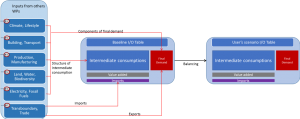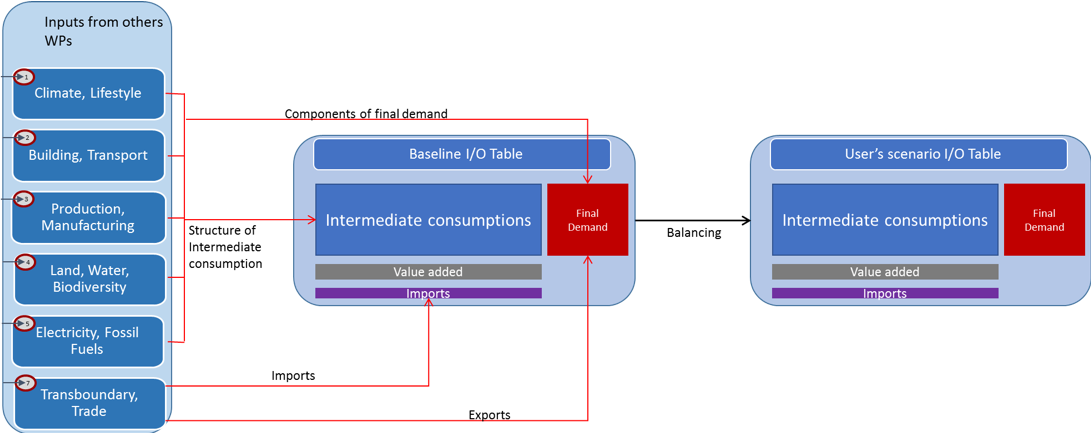Employment
Work Package lead: École Polytechnique Fédérale de Lausanne (EPFL)
Module design
Calculation Flow & Input/ Output Matrix

The module design is described in a tree-like calculation flow and a matrix specifying interactions with other sectors or modules.
Data & Assumptions
Representation of the economy

Overview of the data collected, gathered and presented. Metadata is also provided.
Implementation
Timeline and progress documentation

A timeline and a flow visualization of the programmed module have been created to show progress and compare implementation to the module design
Your feedback and comments are much appreciated, questions will be addressed rapidly.
Module design
The aim of the Employment module is to assess the impacts on employment of the scenario defined by the user.
Baseline Scenario
Using the Computable General Equilibrium model GEMINI-E3, a baseline scenario is simulated. The objective is to model the state of the economy if there was no economic transition. From this simulation, baseline Input-Output (IO) Tables are extracted for all EU countries and Switzerland until 2050.
Input-Output: how the Employment module is linked to others WPs?
The main challenge is to translate bottom-up sectoral inputs from WP1 to WP5 and from WP7 to a top-down representation of the economy. This is done in several steps:
- The baseline IO Tables are updated to account for the difference in GDP growth rate (WP1).
- The final demand is modified with the following inputs: energy demand (WP2); investment in retrofit (WP2); passengers’ activity and car sales (WP2); meat, crops and vegetables consumption (WP4); exports (WP7).
- The structure of intermediate consumption is modified with the following inputs: energy demand in services and transport (WP2), in industry (WP3), and in agriculture (WP4); electricity mix (WP5); investment in retrofit (WP2); freight transport activity and infrastructure spending (WP2); imports (WP7).
- The sectoral output and intermediate consumptions are calculated by balancing the IO Tables.
Finally, the employment is computed from the sectoral output using employment factors.

The inputs used from others WPs are described in more detail in the following table (xlsx – 14KB)
Data & Assumptions
The model is calibrated using the GTAP 9 – Power Database (Peters, 2016). The economy is represented by 39 sectors detailed in the following table:
Industrial classification in the Employment Module
| Employment module Sectors | GTAP 9 Correspondence[1] | |
| 01 | Crops and Vegetables | 1, 2, 3, 4, 5, 6, 7, 8 |
| 02 | Animal Products | 9, 10, 11, 12, 14 |
| 03 | Forestry | 13 |
| 04 | Coal | 15 |
| 05 | Crude Oil | 16 |
| 06 | Petroleum Products | 32 |
| 07 | Gas | 17 |
| 08 | Mining | 18 |
| 09 | Electricity Transmission and Distribution | 43 |
| 10 | Nuclear Base Load | 43 |
| 11 | Coal Base Load | 43 |
| 12 | Gas Base Load | 43 |
| 13 | Wind Base Load | 43 |
| 14 | Hydro Base Load | 43 |
| 15 | Oil Base Load | 43 |
| 16 | Other Base Load | 43 |
| 17 | Gas Peak | 43 |
| 18 | Hydro Peak | 43 |
| 19 | Oil Peak | 43 |
| 20 | Solar Peak | 43 |
| 21 | Gas, Hot Water and Steam | 44 |
| 22 | Water | 45 |
| 23 | Construction | 46 |
| 24 | Land Transport: Rail | 48 |
| 25 | Land Transport: Road | 48 |
| 26 | Water Transport | 49 |
| 27 | Air Transport | 50 |
| 28 | Iron and Steal | 35 |
| 29 | Chemicals | 33 |
| 30 | Non-ferrous metal | 36, 37 |
| 31 | Non-metallic minerals | 34 |
| 32 | Paper, Pulp, Printing | 31 |
| 33 | Processed Animal Food | 19, 20, 22 |
| 34 | Processed Crops and Vegetables, Beverages | 21, 23, 24, 25, 26 |
| 35 | Textile and Leather | 27, 28, 29 |
| 36 | Timber | 30 |
| 37 | Transport Machinery | 38, 39 |
| 38 | Other Industrial | 40, 41, 42 |
| 39 | Services | 47, 51, 52, 53, 54, 55, 56, 57 |
[1] Description of GTAP 9 Sectors: https://www.gtap.agecon.purdue.edu/databases/v9/v9_sectors.asp
Baseline
The baseline scenario was defined in WP7 and is detailed in Deliverable 7.1 (Available soon).
The assumptions on economic growth and energy prices are derived from the EU Reference Scenario 2016 (European Commission 2016). Assumptions on population are based on the recent joint work of the Economic Policy Committee and the European Commission (DG ECFIN) published in 2015 (European Commission 2015).
Implementation
Timeline
The Employment module timeline is summarised in the figure below and highlights key milestones and expected outcomes.

References
European Commission 2015, The 2015 Ageing Report Economic and budgetary projections for the 28 EU Member States, European Economy 3.
European Commission 2016, EU Reference Scenario 2016, Energy, Transport and GHG Emissions trends to 2050.
Peters, J.C. (2016), The GTAP-Power Data Base: Disaggregating the Electricity Sector in the GTAP Data Base. Journal of Global Economic Analysis 1:209-250
Contact point
For questions about the employment module please contact Boris Thurm boris.thurm@epfl.ch
